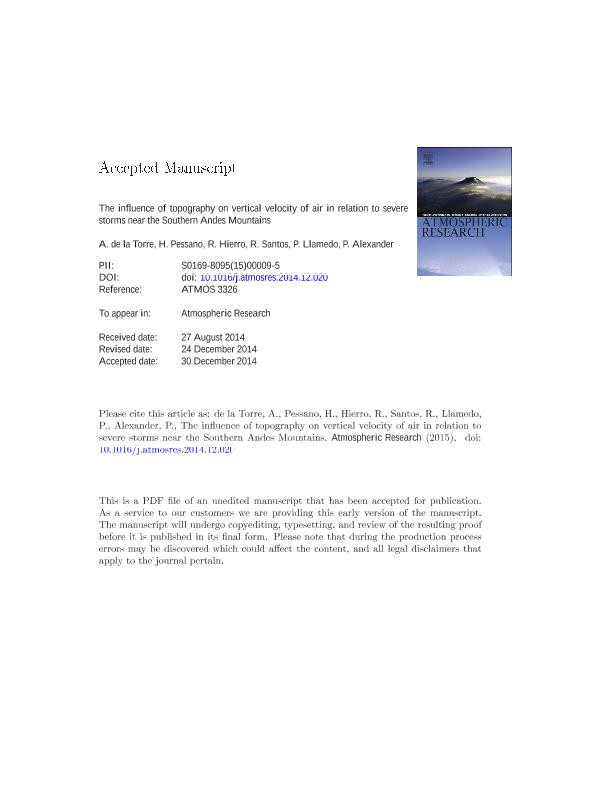Artículo
The influence of topography on vertical velocity of air in relation to severe storms near the Southern Andes Mountains
de la Torre, Alejandro ; Pessano, H.; Hierro, Rodrigo Federico
; Pessano, H.; Hierro, Rodrigo Federico ; Santos, J. R.; Llamedo Soria, Pablo Martin
; Santos, J. R.; Llamedo Soria, Pablo Martin ; Alexander, Pedro Manfredo
; Alexander, Pedro Manfredo
 ; Pessano, H.; Hierro, Rodrigo Federico
; Pessano, H.; Hierro, Rodrigo Federico ; Santos, J. R.; Llamedo Soria, Pablo Martin
; Santos, J. R.; Llamedo Soria, Pablo Martin ; Alexander, Pedro Manfredo
; Alexander, Pedro Manfredo
Fecha de publicación:
04/2015
Editorial:
Elsevier Science
Revista:
Atmospheric Research
ISSN:
0169-8095
Idioma:
Inglés
Tipo de recurso:
Artículo publicado
Clasificación temática:
Resumen
On the basis of 180 storms which took place between 2004 and 2011 over the province of Mendoza (Argentina) near to the Andes Range at southern mid-latitudes, we consider those registered in the northern and central crop areas (oases). The regions affected by these storms are currently protected by an operational hail mitigation project. Differences with previously reported storms detected in the southern oasis are highlighted. Mendoza is a semiarid region situated roughly between 32S and 37S at the east of the highest Andes top. It forms a natural laboratory where different sources of gravity waves, mainly mountain waves, occur. In this work, we analyze the effects of flow over topography generating mountain waves and favoring deep convection. The joint occurrence of storms with hail production and mountain waves is determined from mesoscale numerical simulations, radar and radiosounding data. In particular, two case studies that properly represent diverse structures observed in the region are considered in detail. A continuous wavelet transform is applied to each variable and profile to detect the main oscillation modes present. Simulated temperature profiles are validated and compared with radiosounding data. Each first radar echo, time and location are determined. The necessary energy to lift a parcel to its level of free convection is tested from the Convective Available Potential Energy and Convection Inhibition. This last parameter is compared against the mountain waves' vertical kinetic energy. The time evolution and vertical structure of vertical velocity and equivalent potential temperature suggest in both cases that the detected mountain wave amplitudes are able to provide the necessary energy to lift the air parcel and trigger convection. A simple conceptual scheme linking the dynamical factors taking place before and during storm development is proposed.
Palabras clave:
Mountain Waves
,
Storms
,
Andes
,
Mendoza
Archivos asociados
Licencia
Identificadores
Colecciones
Articulos(IFIBA)
Articulos de INST.DE FISICA DE BUENOS AIRES
Articulos de INST.DE FISICA DE BUENOS AIRES
Citación
de la Torre, Alejandro; Pessano, H.; Hierro, Rodrigo Federico; Santos, J. R.; Llamedo Soria, Pablo Martin; et al.; The influence of topography on vertical velocity of air in relation to severe storms near the Southern Andes Mountains; Elsevier Science; Atmospheric Research; 156; 4-2015; 91-101
Compartir
Altmétricas



